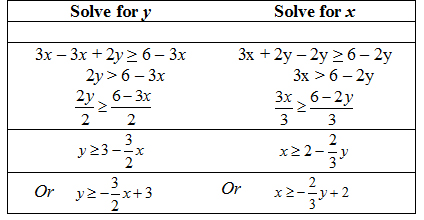
Linear inequalities can be transformed in a way that is similar to linear equalities. This first example shows how to transform an inequality.
Example 1: What is another way to write the following inequality?
3x + 2y ≥ 6
What is the question asking you to do? The question is asking you to write the inequality another way, but to make sure that the value of the solutions for the inequality remains the same.
Make a plan for writing the inequality in another way. We can rewrite the inequality by solving for y, OR we can rewrite the inequality by solving for x. Let’s try both.

In both cases above, the value of the inequality remains the same.
However, there is an important difference to note.
On your own paper, complete the table below, including the appropriate inequality symbol. The first row has been completed for you.
![]() Scroll over the table to check your answers.
Scroll over the table to check your answers.
What happens to the inequality symbol when a and b are multiplied by -1?
Interactive popup. Assistance may be required. The inequality symbol is reversed.
Whenever a linear inequality is multiplied or divided by a negative number, the inequality symbol must be reversed in order to preserve the value of the inequality.
![]() View this video to find out more.
View this video to find out more.
Source: Solving Equations and Inequalities, pae005, YouTube